PUBH6005 Epidemiology: Critical Appraisal of Antibiotics and Obesity
VerifiedAdded on 2023/06/07
|13
|4005
|492
Essay
AI Summary
This critical appraisal essay examines the potential link between antibiotic exposure in early childhood and the development of obesity. It critically appraises five peer-reviewed cohort studies using the CASP checklist and NHMRC body of evidence matrix to assess the quality and consistency of evidence. The analysis focuses on studies investigating the association between antibiotic administration in infancy and subsequent risk of childhood overweight and adiposity. The essay discusses the study designs, methodologies, and findings of each article, highlighting the potential implications of early-life antibiotic exposure on long-term metabolic health. The overall assessment suggests a possible association between early antibiotic use and increased risk of childhood obesity, warranting further research and cautious use of antibiotics in young children. Desklib offers a wealth of similar solved assignments and study resources for students.
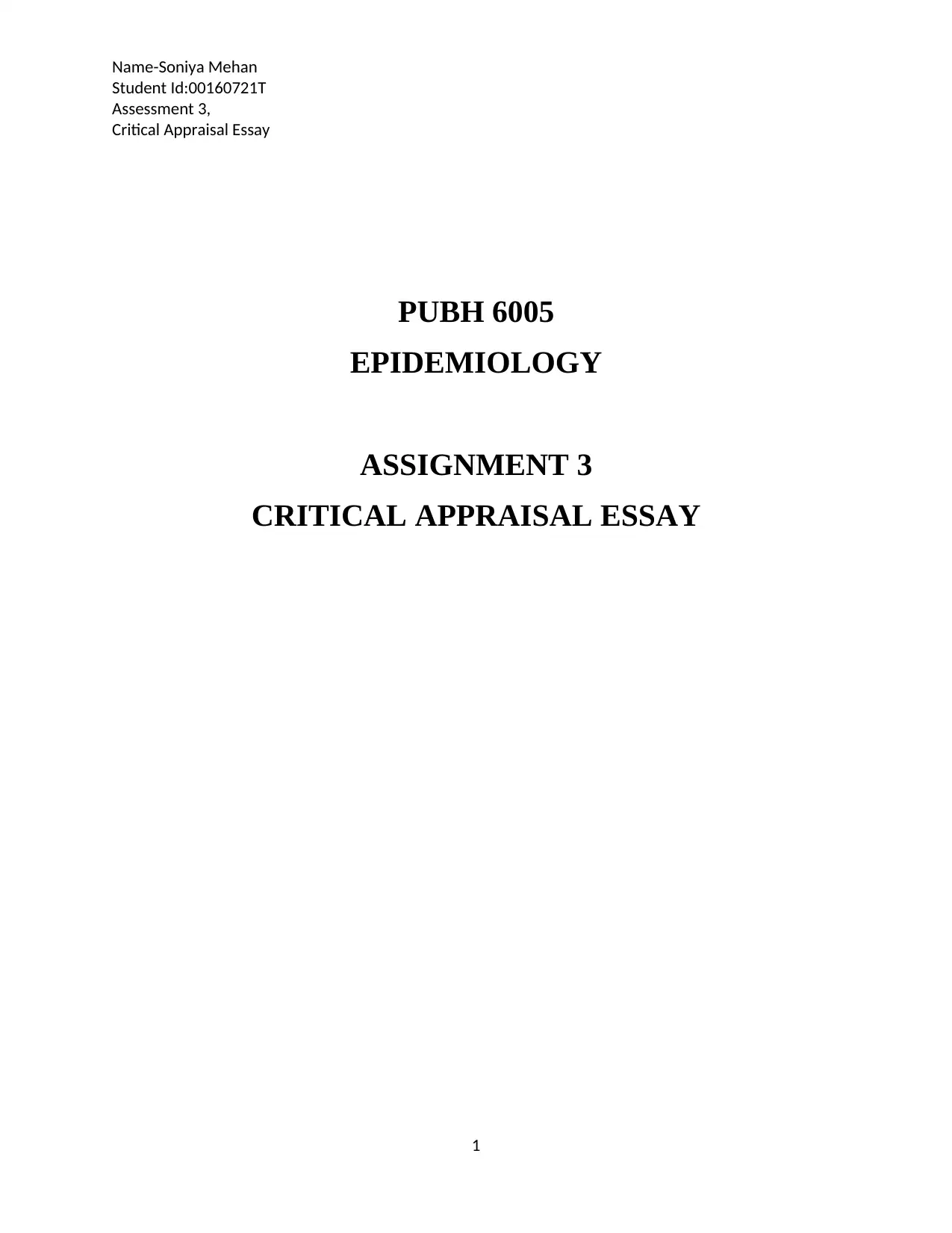
Name-Soniya Mehan
Student Id:00160721T
Assessment 3,
Critical Appraisal Essay
PUBH 6005
EPIDEMIOLOGY
ASSIGNMENT 3
CRITICAL APPRAISAL ESSAY
1
Student Id:00160721T
Assessment 3,
Critical Appraisal Essay
PUBH 6005
EPIDEMIOLOGY
ASSIGNMENT 3
CRITICAL APPRAISAL ESSAY
1
Paraphrase This Document
Need a fresh take? Get an instant paraphrase of this document with our AI Paraphraser
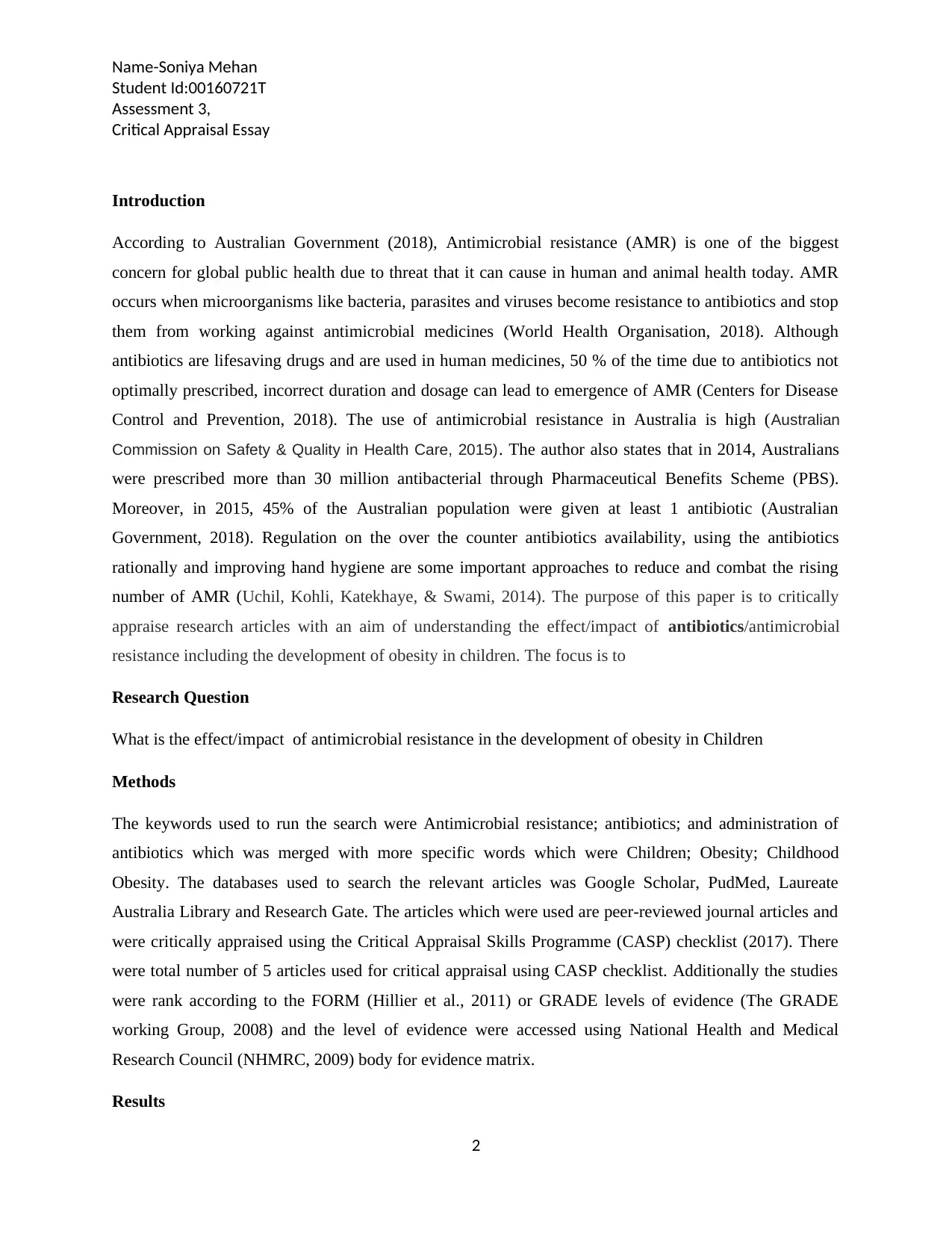
Name-Soniya Mehan
Student Id:00160721T
Assessment 3,
Critical Appraisal Essay
Introduction
According to Australian Government (2018), Antimicrobial resistance (AMR) is one of the biggest
concern for global public health due to threat that it can cause in human and animal health today. AMR
occurs when microorganisms like bacteria, parasites and viruses become resistance to antibiotics and stop
them from working against antimicrobial medicines (World Health Organisation, 2018). Although
antibiotics are lifesaving drugs and are used in human medicines, 50 % of the time due to antibiotics not
optimally prescribed, incorrect duration and dosage can lead to emergence of AMR (Centers for Disease
Control and Prevention, 2018). The use of antimicrobial resistance in Australia is high (Australian
Commission on Safety & Quality in Health Care, 2015). The author also states that in 2014, Australians
were prescribed more than 30 million antibacterial through Pharmaceutical Benefits Scheme (PBS).
Moreover, in 2015, 45% of the Australian population were given at least 1 antibiotic (Australian
Government, 2018). Regulation on the over the counter antibiotics availability, using the antibiotics
rationally and improving hand hygiene are some important approaches to reduce and combat the rising
number of AMR (Uchil, Kohli, Katekhaye, & Swami, 2014). The purpose of this paper is to critically
appraise research articles with an aim of understanding the effect/impact of antibiotics/antimicrobial
resistance including the development of obesity in children. The focus is to
Research Question
What is the effect/impact of antimicrobial resistance in the development of obesity in Children
Methods
The keywords used to run the search were Antimicrobial resistance; antibiotics; and administration of
antibiotics which was merged with more specific words which were Children; Obesity; Childhood
Obesity. The databases used to search the relevant articles was Google Scholar, PudMed, Laureate
Australia Library and Research Gate. The articles which were used are peer-reviewed journal articles and
were critically appraised using the Critical Appraisal Skills Programme (CASP) checklist (2017). There
were total number of 5 articles used for critical appraisal using CASP checklist. Additionally the studies
were rank according to the FORM (Hillier et al., 2011) or GRADE levels of evidence (The GRADE
working Group, 2008) and the level of evidence were accessed using National Health and Medical
Research Council (NHMRC, 2009) body for evidence matrix.
Results
2
Student Id:00160721T
Assessment 3,
Critical Appraisal Essay
Introduction
According to Australian Government (2018), Antimicrobial resistance (AMR) is one of the biggest
concern for global public health due to threat that it can cause in human and animal health today. AMR
occurs when microorganisms like bacteria, parasites and viruses become resistance to antibiotics and stop
them from working against antimicrobial medicines (World Health Organisation, 2018). Although
antibiotics are lifesaving drugs and are used in human medicines, 50 % of the time due to antibiotics not
optimally prescribed, incorrect duration and dosage can lead to emergence of AMR (Centers for Disease
Control and Prevention, 2018). The use of antimicrobial resistance in Australia is high (Australian
Commission on Safety & Quality in Health Care, 2015). The author also states that in 2014, Australians
were prescribed more than 30 million antibacterial through Pharmaceutical Benefits Scheme (PBS).
Moreover, in 2015, 45% of the Australian population were given at least 1 antibiotic (Australian
Government, 2018). Regulation on the over the counter antibiotics availability, using the antibiotics
rationally and improving hand hygiene are some important approaches to reduce and combat the rising
number of AMR (Uchil, Kohli, Katekhaye, & Swami, 2014). The purpose of this paper is to critically
appraise research articles with an aim of understanding the effect/impact of antibiotics/antimicrobial
resistance including the development of obesity in children. The focus is to
Research Question
What is the effect/impact of antimicrobial resistance in the development of obesity in Children
Methods
The keywords used to run the search were Antimicrobial resistance; antibiotics; and administration of
antibiotics which was merged with more specific words which were Children; Obesity; Childhood
Obesity. The databases used to search the relevant articles was Google Scholar, PudMed, Laureate
Australia Library and Research Gate. The articles which were used are peer-reviewed journal articles and
were critically appraised using the Critical Appraisal Skills Programme (CASP) checklist (2017). There
were total number of 5 articles used for critical appraisal using CASP checklist. Additionally the studies
were rank according to the FORM (Hillier et al., 2011) or GRADE levels of evidence (The GRADE
working Group, 2008) and the level of evidence were accessed using National Health and Medical
Research Council (NHMRC, 2009) body for evidence matrix.
Results
2
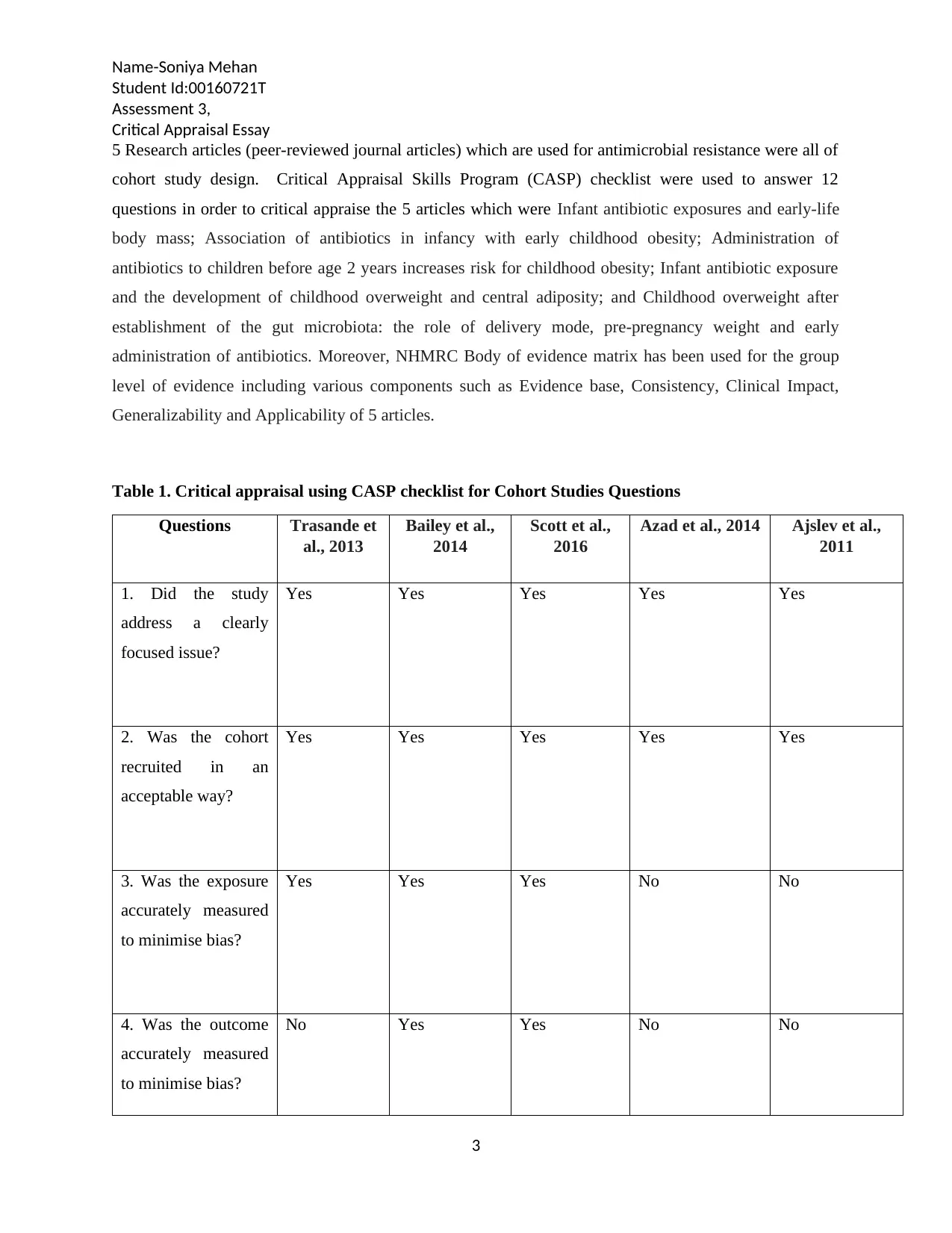
Name-Soniya Mehan
Student Id:00160721T
Assessment 3,
Critical Appraisal Essay
5 Research articles (peer-reviewed journal articles) which are used for antimicrobial resistance were all of
cohort study design. Critical Appraisal Skills Program (CASP) checklist were used to answer 12
questions in order to critical appraise the 5 articles which were Infant antibiotic exposures and early-life
body mass; Association of antibiotics in infancy with early childhood obesity; Administration of
antibiotics to children before age 2 years increases risk for childhood obesity; Infant antibiotic exposure
and the development of childhood overweight and central adiposity; and Childhood overweight after
establishment of the gut microbiota: the role of delivery mode, pre-pregnancy weight and early
administration of antibiotics. Moreover, NHMRC Body of evidence matrix has been used for the group
level of evidence including various components such as Evidence base, Consistency, Clinical Impact,
Generalizability and Applicability of 5 articles.
Table 1. Critical appraisal using CASP checklist for Cohort Studies Questions
Questions Trasande et
al., 2013
Bailey et al.,
2014
Scott et al.,
2016
Azad et al., 2014 Ajslev et al.,
2011
1. Did the study
address a clearly
focused issue?
Yes Yes Yes Yes Yes
2. Was the cohort
recruited in an
acceptable way?
Yes Yes Yes Yes Yes
3. Was the exposure
accurately measured
to minimise bias?
Yes Yes Yes No No
4. Was the outcome
accurately measured
to minimise bias?
No Yes Yes No No
3
Student Id:00160721T
Assessment 3,
Critical Appraisal Essay
5 Research articles (peer-reviewed journal articles) which are used for antimicrobial resistance were all of
cohort study design. Critical Appraisal Skills Program (CASP) checklist were used to answer 12
questions in order to critical appraise the 5 articles which were Infant antibiotic exposures and early-life
body mass; Association of antibiotics in infancy with early childhood obesity; Administration of
antibiotics to children before age 2 years increases risk for childhood obesity; Infant antibiotic exposure
and the development of childhood overweight and central adiposity; and Childhood overweight after
establishment of the gut microbiota: the role of delivery mode, pre-pregnancy weight and early
administration of antibiotics. Moreover, NHMRC Body of evidence matrix has been used for the group
level of evidence including various components such as Evidence base, Consistency, Clinical Impact,
Generalizability and Applicability of 5 articles.
Table 1. Critical appraisal using CASP checklist for Cohort Studies Questions
Questions Trasande et
al., 2013
Bailey et al.,
2014
Scott et al.,
2016
Azad et al., 2014 Ajslev et al.,
2011
1. Did the study
address a clearly
focused issue?
Yes Yes Yes Yes Yes
2. Was the cohort
recruited in an
acceptable way?
Yes Yes Yes Yes Yes
3. Was the exposure
accurately measured
to minimise bias?
Yes Yes Yes No No
4. Was the outcome
accurately measured
to minimise bias?
No Yes Yes No No
3
⊘ This is a preview!⊘
Do you want full access?
Subscribe today to unlock all pages.

Trusted by 1+ million students worldwide
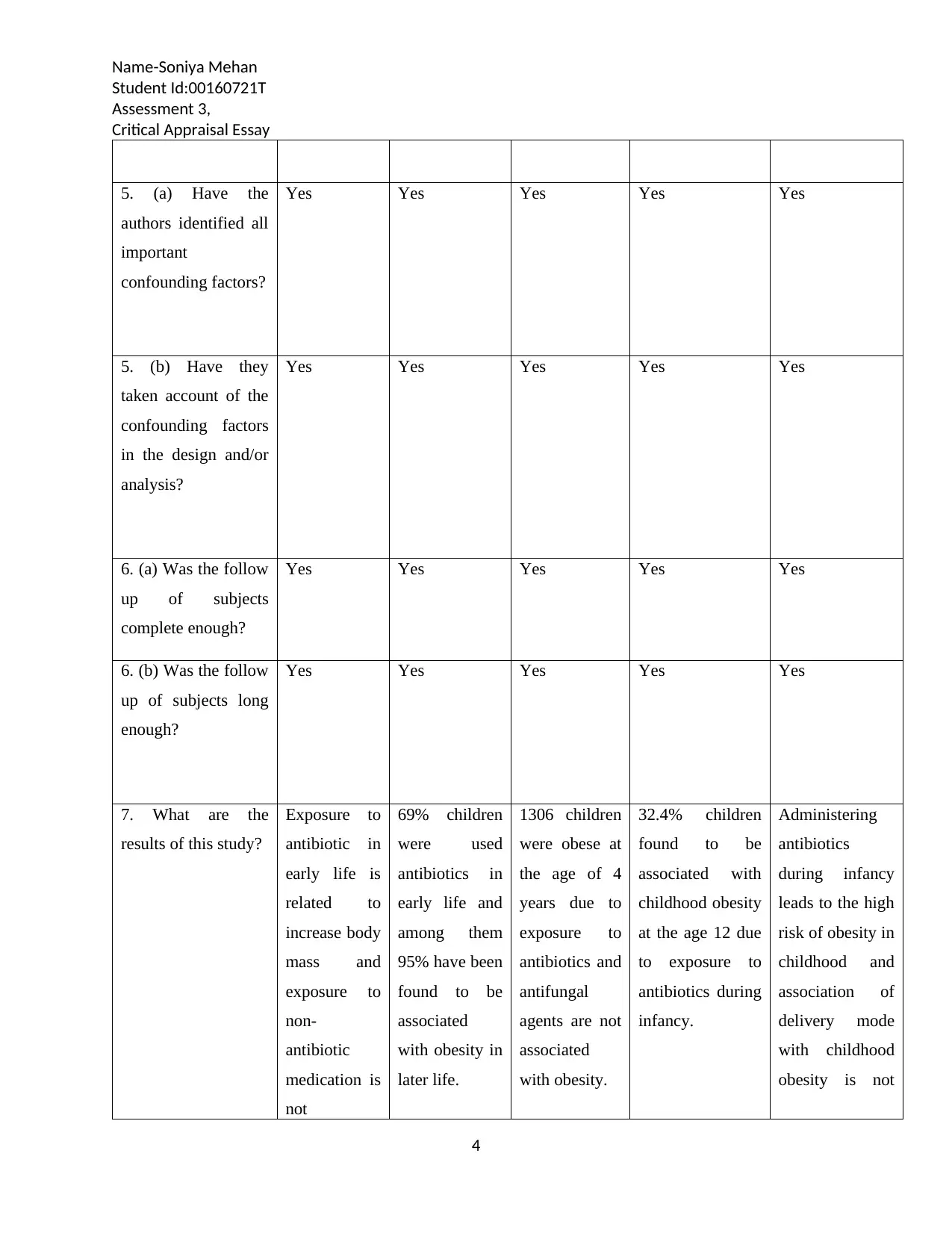
Name-Soniya Mehan
Student Id:00160721T
Assessment 3,
Critical Appraisal Essay
5. (a) Have the
authors identified all
important
confounding factors?
Yes Yes Yes Yes Yes
5. (b) Have they
taken account of the
confounding factors
in the design and/or
analysis?
Yes Yes Yes Yes Yes
6. (a) Was the follow
up of subjects
complete enough?
Yes Yes Yes Yes Yes
6. (b) Was the follow
up of subjects long
enough?
Yes Yes Yes Yes Yes
7. What are the
results of this study?
Exposure to
antibiotic in
early life is
related to
increase body
mass and
exposure to
non-
antibiotic
medication is
not
69% children
were used
antibiotics in
early life and
among them
95% have been
found to be
associated
with obesity in
later life.
1306 children
were obese at
the age of 4
years due to
exposure to
antibiotics and
antifungal
agents are not
associated
with obesity.
32.4% children
found to be
associated with
childhood obesity
at the age 12 due
to exposure to
antibiotics during
infancy.
Administering
antibiotics
during infancy
leads to the high
risk of obesity in
childhood and
association of
delivery mode
with childhood
obesity is not
4
Student Id:00160721T
Assessment 3,
Critical Appraisal Essay
5. (a) Have the
authors identified all
important
confounding factors?
Yes Yes Yes Yes Yes
5. (b) Have they
taken account of the
confounding factors
in the design and/or
analysis?
Yes Yes Yes Yes Yes
6. (a) Was the follow
up of subjects
complete enough?
Yes Yes Yes Yes Yes
6. (b) Was the follow
up of subjects long
enough?
Yes Yes Yes Yes Yes
7. What are the
results of this study?
Exposure to
antibiotic in
early life is
related to
increase body
mass and
exposure to
non-
antibiotic
medication is
not
69% children
were used
antibiotics in
early life and
among them
95% have been
found to be
associated
with obesity in
later life.
1306 children
were obese at
the age of 4
years due to
exposure to
antibiotics and
antifungal
agents are not
associated
with obesity.
32.4% children
found to be
associated with
childhood obesity
at the age 12 due
to exposure to
antibiotics during
infancy.
Administering
antibiotics
during infancy
leads to the high
risk of obesity in
childhood and
association of
delivery mode
with childhood
obesity is not
4
Paraphrase This Document
Need a fresh take? Get an instant paraphrase of this document with our AI Paraphraser
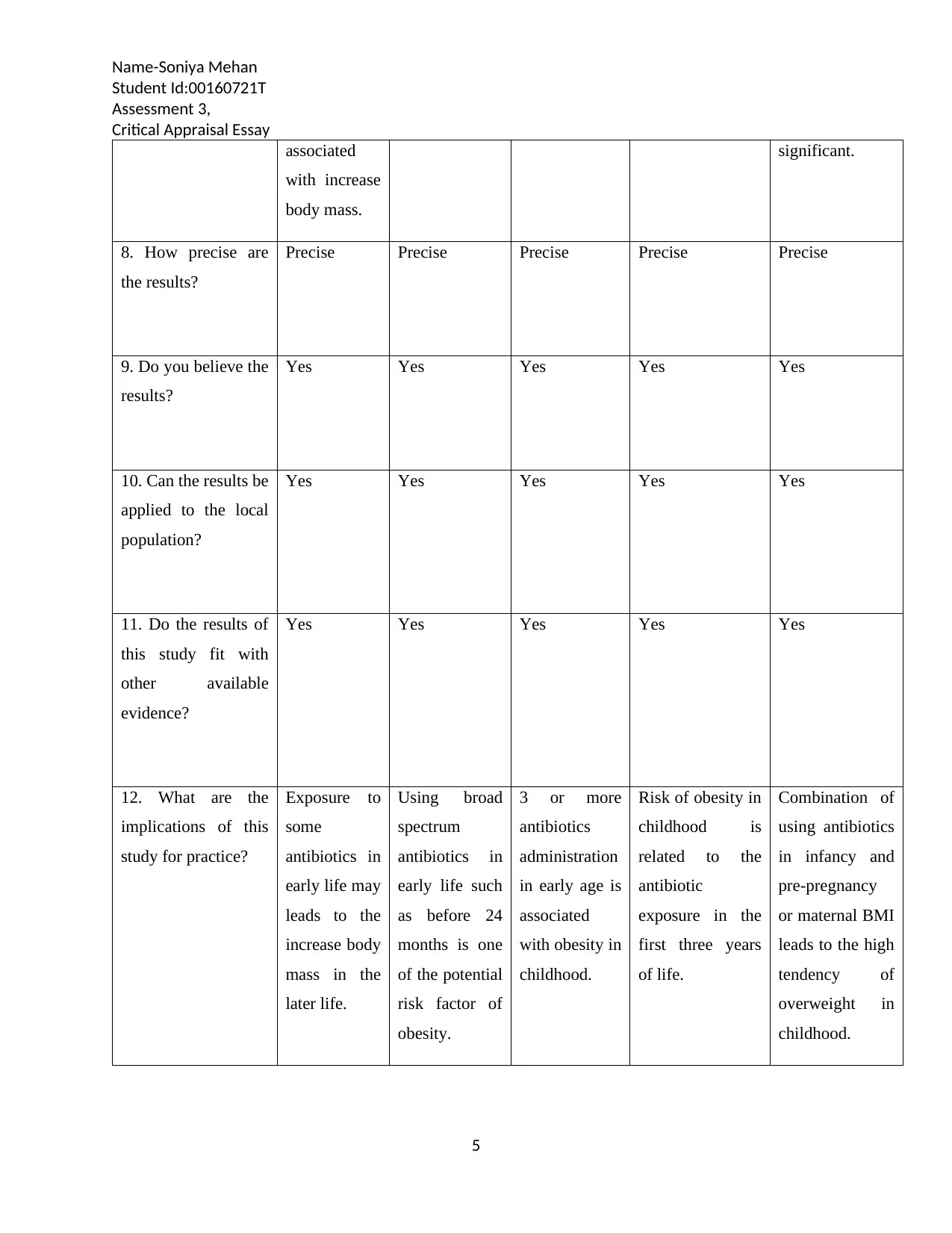
Name-Soniya Mehan
Student Id:00160721T
Assessment 3,
Critical Appraisal Essay
associated
with increase
body mass.
significant.
8. How precise are
the results?
Precise Precise Precise Precise Precise
9. Do you believe the
results?
Yes Yes Yes Yes Yes
10. Can the results be
applied to the local
population?
Yes Yes Yes Yes Yes
11. Do the results of
this study fit with
other available
evidence?
Yes Yes Yes Yes Yes
12. What are the
implications of this
study for practice?
Exposure to
some
antibiotics in
early life may
leads to the
increase body
mass in the
later life.
Using broad
spectrum
antibiotics in
early life such
as before 24
months is one
of the potential
risk factor of
obesity.
3 or more
antibiotics
administration
in early age is
associated
with obesity in
childhood.
Risk of obesity in
childhood is
related to the
antibiotic
exposure in the
first three years
of life.
Combination of
using antibiotics
in infancy and
pre-pregnancy
or maternal BMI
leads to the high
tendency of
overweight in
childhood.
5
Student Id:00160721T
Assessment 3,
Critical Appraisal Essay
associated
with increase
body mass.
significant.
8. How precise are
the results?
Precise Precise Precise Precise Precise
9. Do you believe the
results?
Yes Yes Yes Yes Yes
10. Can the results be
applied to the local
population?
Yes Yes Yes Yes Yes
11. Do the results of
this study fit with
other available
evidence?
Yes Yes Yes Yes Yes
12. What are the
implications of this
study for practice?
Exposure to
some
antibiotics in
early life may
leads to the
increase body
mass in the
later life.
Using broad
spectrum
antibiotics in
early life such
as before 24
months is one
of the potential
risk factor of
obesity.
3 or more
antibiotics
administration
in early age is
associated
with obesity in
childhood.
Risk of obesity in
childhood is
related to the
antibiotic
exposure in the
first three years
of life.
Combination of
using antibiotics
in infancy and
pre-pregnancy
or maternal BMI
leads to the high
tendency of
overweight in
childhood.
5
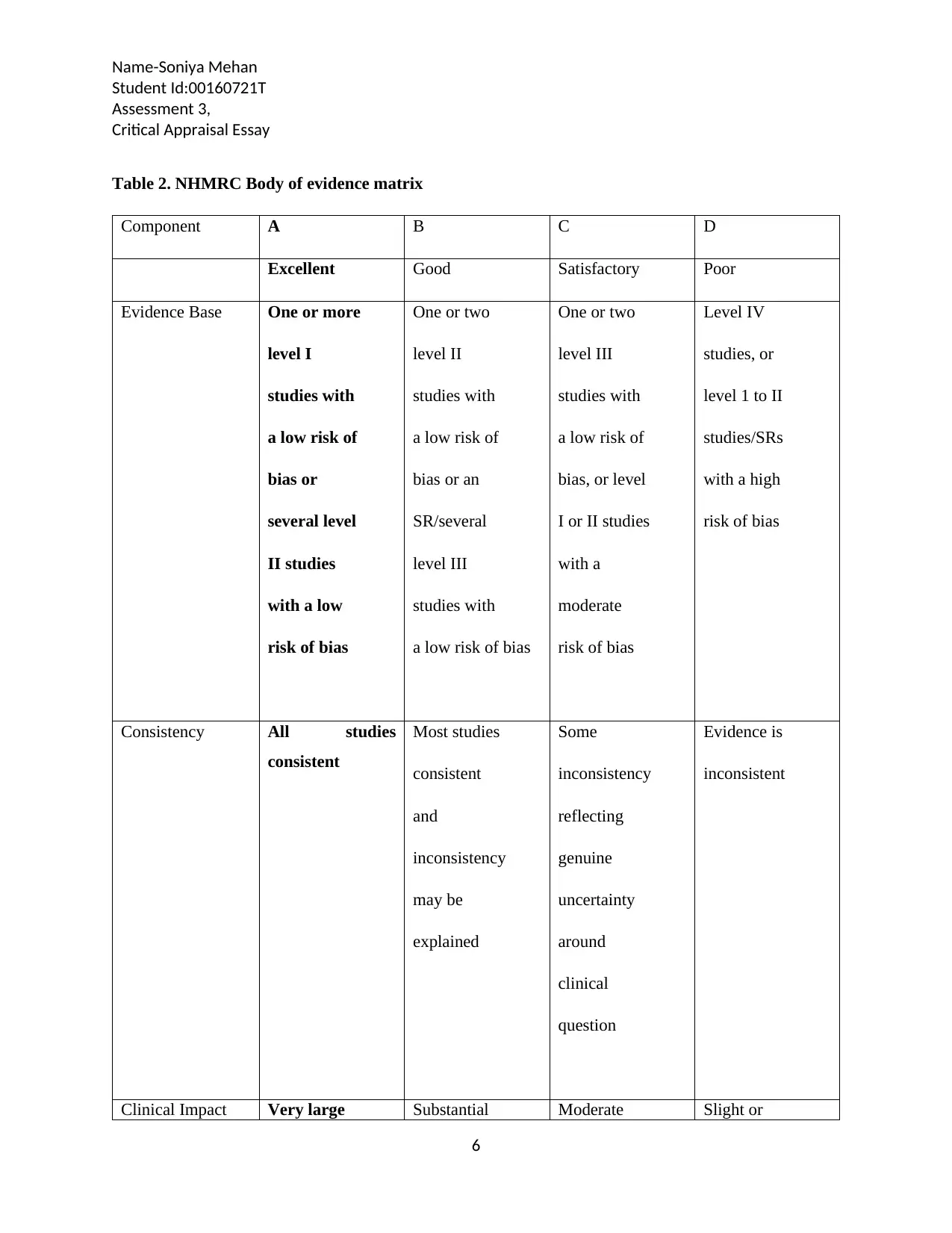
Name-Soniya Mehan
Student Id:00160721T
Assessment 3,
Critical Appraisal Essay
Table 2. NHMRC Body of evidence matrix
Component A B C D
Excellent Good Satisfactory Poor
Evidence Base One or more
level I
studies with
a low risk of
bias or
several level
II studies
with a low
risk of bias
One or two
level II
studies with
a low risk of
bias or an
SR/several
level III
studies with
a low risk of bias
One or two
level III
studies with
a low risk of
bias, or level
I or II studies
with a
moderate
risk of bias
Level IV
studies, or
level 1 to II
studies/SRs
with a high
risk of bias
Consistency All studies
consistent
Most studies
consistent
and
inconsistency
may be
explained
Some
inconsistency
reflecting
genuine
uncertainty
around
clinical
question
Evidence is
inconsistent
Clinical Impact Very large Substantial Moderate Slight or
6
Student Id:00160721T
Assessment 3,
Critical Appraisal Essay
Table 2. NHMRC Body of evidence matrix
Component A B C D
Excellent Good Satisfactory Poor
Evidence Base One or more
level I
studies with
a low risk of
bias or
several level
II studies
with a low
risk of bias
One or two
level II
studies with
a low risk of
bias or an
SR/several
level III
studies with
a low risk of bias
One or two
level III
studies with
a low risk of
bias, or level
I or II studies
with a
moderate
risk of bias
Level IV
studies, or
level 1 to II
studies/SRs
with a high
risk of bias
Consistency All studies
consistent
Most studies
consistent
and
inconsistency
may be
explained
Some
inconsistency
reflecting
genuine
uncertainty
around
clinical
question
Evidence is
inconsistent
Clinical Impact Very large Substantial Moderate Slight or
6
⊘ This is a preview!⊘
Do you want full access?
Subscribe today to unlock all pages.

Trusted by 1+ million students worldwide
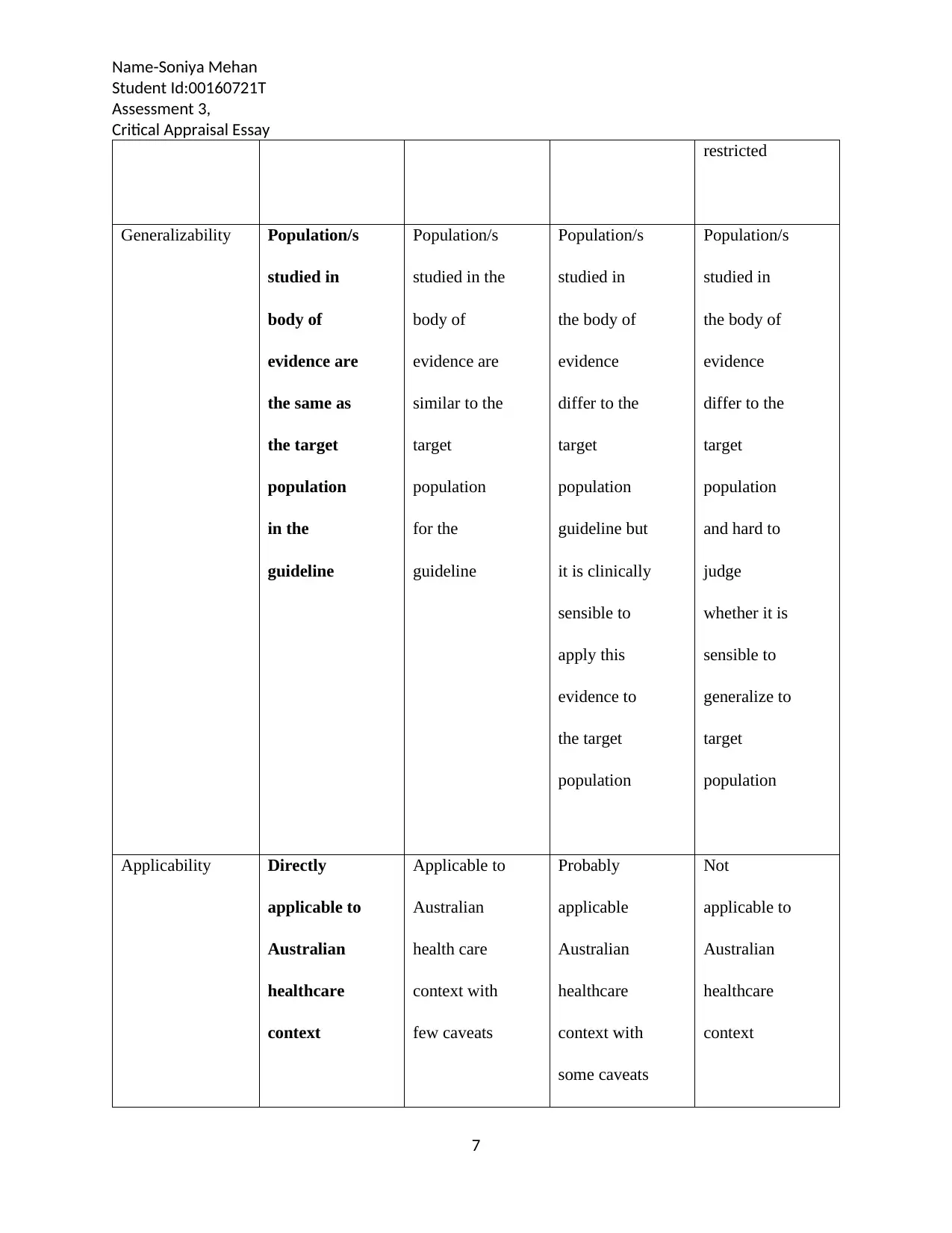
Name-Soniya Mehan
Student Id:00160721T
Assessment 3,
Critical Appraisal Essay
restricted
Generalizability Population/s
studied in
body of
evidence are
the same as
the target
population
in the
guideline
Population/s
studied in the
body of
evidence are
similar to the
target
population
for the
guideline
Population/s
studied in
the body of
evidence
differ to the
target
population
guideline but
it is clinically
sensible to
apply this
evidence to
the target
population
Population/s
studied in
the body of
evidence
differ to the
target
population
and hard to
judge
whether it is
sensible to
generalize to
target
population
Applicability Directly
applicable to
Australian
healthcare
context
Applicable to
Australian
health care
context with
few caveats
Probably
applicable
Australian
healthcare
context with
some caveats
Not
applicable to
Australian
healthcare
context
7
Student Id:00160721T
Assessment 3,
Critical Appraisal Essay
restricted
Generalizability Population/s
studied in
body of
evidence are
the same as
the target
population
in the
guideline
Population/s
studied in the
body of
evidence are
similar to the
target
population
for the
guideline
Population/s
studied in
the body of
evidence
differ to the
target
population
guideline but
it is clinically
sensible to
apply this
evidence to
the target
population
Population/s
studied in
the body of
evidence
differ to the
target
population
and hard to
judge
whether it is
sensible to
generalize to
target
population
Applicability Directly
applicable to
Australian
healthcare
context
Applicable to
Australian
health care
context with
few caveats
Probably
applicable
Australian
healthcare
context with
some caveats
Not
applicable to
Australian
healthcare
context
7
Paraphrase This Document
Need a fresh take? Get an instant paraphrase of this document with our AI Paraphraser
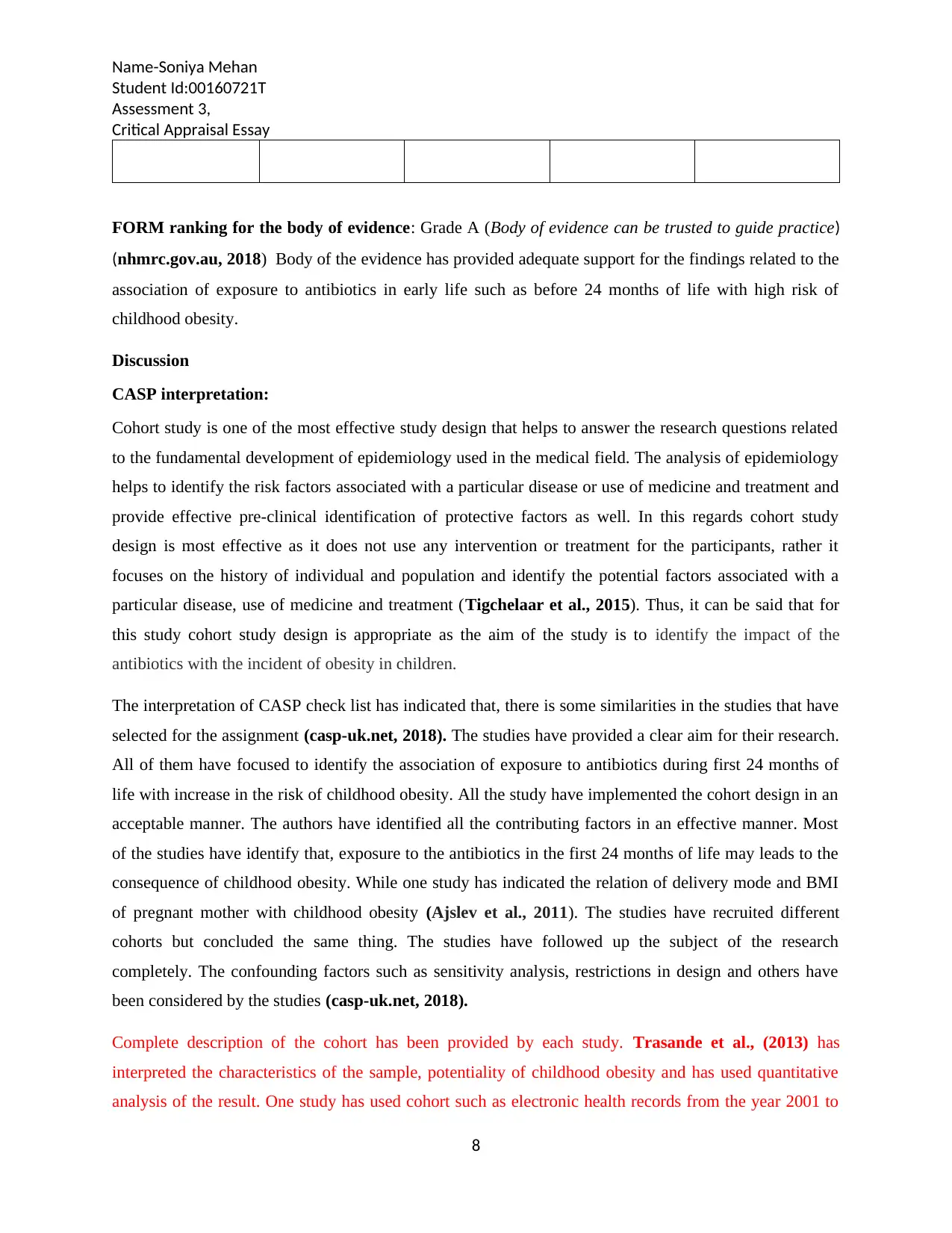
Name-Soniya Mehan
Student Id:00160721T
Assessment 3,
Critical Appraisal Essay
FORM ranking for the body of evidence: Grade A (Body of evidence can be trusted to guide practice)
(nhmrc.gov.au, 2018) Body of the evidence has provided adequate support for the findings related to the
association of exposure to antibiotics in early life such as before 24 months of life with high risk of
childhood obesity.
Discussion
CASP interpretation:
Cohort study is one of the most effective study design that helps to answer the research questions related
to the fundamental development of epidemiology used in the medical field. The analysis of epidemiology
helps to identify the risk factors associated with a particular disease or use of medicine and treatment and
provide effective pre-clinical identification of protective factors as well. In this regards cohort study
design is most effective as it does not use any intervention or treatment for the participants, rather it
focuses on the history of individual and population and identify the potential factors associated with a
particular disease, use of medicine and treatment (Tigchelaar et al., 2015). Thus, it can be said that for
this study cohort study design is appropriate as the aim of the study is to identify the impact of the
antibiotics with the incident of obesity in children.
The interpretation of CASP check list has indicated that, there is some similarities in the studies that have
selected for the assignment (casp-uk.net, 2018). The studies have provided a clear aim for their research.
All of them have focused to identify the association of exposure to antibiotics during first 24 months of
life with increase in the risk of childhood obesity. All the study have implemented the cohort design in an
acceptable manner. The authors have identified all the contributing factors in an effective manner. Most
of the studies have identify that, exposure to the antibiotics in the first 24 months of life may leads to the
consequence of childhood obesity. While one study has indicated the relation of delivery mode and BMI
of pregnant mother with childhood obesity (Ajslev et al., 2011). The studies have recruited different
cohorts but concluded the same thing. The studies have followed up the subject of the research
completely. The confounding factors such as sensitivity analysis, restrictions in design and others have
been considered by the studies (casp-uk.net, 2018).
Complete description of the cohort has been provided by each study. Trasande et al., (2013) has
interpreted the characteristics of the sample, potentiality of childhood obesity and has used quantitative
analysis of the result. One study has used cohort such as electronic health records from the year 2001 to
8
Student Id:00160721T
Assessment 3,
Critical Appraisal Essay
FORM ranking for the body of evidence: Grade A (Body of evidence can be trusted to guide practice)
(nhmrc.gov.au, 2018) Body of the evidence has provided adequate support for the findings related to the
association of exposure to antibiotics in early life such as before 24 months of life with high risk of
childhood obesity.
Discussion
CASP interpretation:
Cohort study is one of the most effective study design that helps to answer the research questions related
to the fundamental development of epidemiology used in the medical field. The analysis of epidemiology
helps to identify the risk factors associated with a particular disease or use of medicine and treatment and
provide effective pre-clinical identification of protective factors as well. In this regards cohort study
design is most effective as it does not use any intervention or treatment for the participants, rather it
focuses on the history of individual and population and identify the potential factors associated with a
particular disease, use of medicine and treatment (Tigchelaar et al., 2015). Thus, it can be said that for
this study cohort study design is appropriate as the aim of the study is to identify the impact of the
antibiotics with the incident of obesity in children.
The interpretation of CASP check list has indicated that, there is some similarities in the studies that have
selected for the assignment (casp-uk.net, 2018). The studies have provided a clear aim for their research.
All of them have focused to identify the association of exposure to antibiotics during first 24 months of
life with increase in the risk of childhood obesity. All the study have implemented the cohort design in an
acceptable manner. The authors have identified all the contributing factors in an effective manner. Most
of the studies have identify that, exposure to the antibiotics in the first 24 months of life may leads to the
consequence of childhood obesity. While one study has indicated the relation of delivery mode and BMI
of pregnant mother with childhood obesity (Ajslev et al., 2011). The studies have recruited different
cohorts but concluded the same thing. The studies have followed up the subject of the research
completely. The confounding factors such as sensitivity analysis, restrictions in design and others have
been considered by the studies (casp-uk.net, 2018).
Complete description of the cohort has been provided by each study. Trasande et al., (2013) has
interpreted the characteristics of the sample, potentiality of childhood obesity and has used quantitative
analysis of the result. One study has used cohort such as electronic health records from the year 2001 to
8
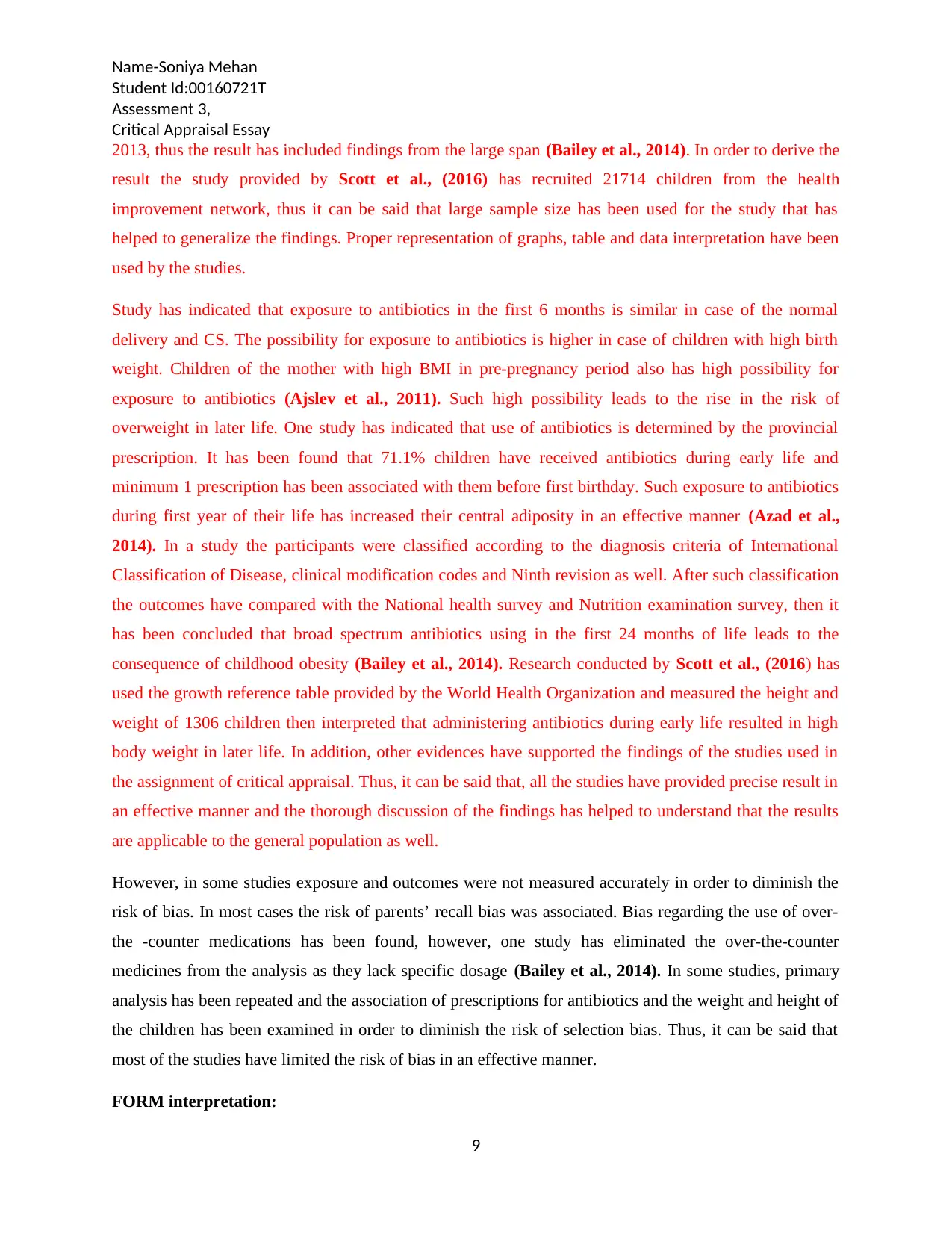
Name-Soniya Mehan
Student Id:00160721T
Assessment 3,
Critical Appraisal Essay
2013, thus the result has included findings from the large span (Bailey et al., 2014). In order to derive the
result the study provided by Scott et al., (2016) has recruited 21714 children from the health
improvement network, thus it can be said that large sample size has been used for the study that has
helped to generalize the findings. Proper representation of graphs, table and data interpretation have been
used by the studies.
Study has indicated that exposure to antibiotics in the first 6 months is similar in case of the normal
delivery and CS. The possibility for exposure to antibiotics is higher in case of children with high birth
weight. Children of the mother with high BMI in pre-pregnancy period also has high possibility for
exposure to antibiotics (Ajslev et al., 2011). Such high possibility leads to the rise in the risk of
overweight in later life. One study has indicated that use of antibiotics is determined by the provincial
prescription. It has been found that 71.1% children have received antibiotics during early life and
minimum 1 prescription has been associated with them before first birthday. Such exposure to antibiotics
during first year of their life has increased their central adiposity in an effective manner (Azad et al.,
2014). In a study the participants were classified according to the diagnosis criteria of International
Classification of Disease, clinical modification codes and Ninth revision as well. After such classification
the outcomes have compared with the National health survey and Nutrition examination survey, then it
has been concluded that broad spectrum antibiotics using in the first 24 months of life leads to the
consequence of childhood obesity (Bailey et al., 2014). Research conducted by Scott et al., (2016) has
used the growth reference table provided by the World Health Organization and measured the height and
weight of 1306 children then interpreted that administering antibiotics during early life resulted in high
body weight in later life. In addition, other evidences have supported the findings of the studies used in
the assignment of critical appraisal. Thus, it can be said that, all the studies have provided precise result in
an effective manner and the thorough discussion of the findings has helped to understand that the results
are applicable to the general population as well.
However, in some studies exposure and outcomes were not measured accurately in order to diminish the
risk of bias. In most cases the risk of parents’ recall bias was associated. Bias regarding the use of over-
the -counter medications has been found, however, one study has eliminated the over-the-counter
medicines from the analysis as they lack specific dosage (Bailey et al., 2014). In some studies, primary
analysis has been repeated and the association of prescriptions for antibiotics and the weight and height of
the children has been examined in order to diminish the risk of selection bias. Thus, it can be said that
most of the studies have limited the risk of bias in an effective manner.
FORM interpretation:
9
Student Id:00160721T
Assessment 3,
Critical Appraisal Essay
2013, thus the result has included findings from the large span (Bailey et al., 2014). In order to derive the
result the study provided by Scott et al., (2016) has recruited 21714 children from the health
improvement network, thus it can be said that large sample size has been used for the study that has
helped to generalize the findings. Proper representation of graphs, table and data interpretation have been
used by the studies.
Study has indicated that exposure to antibiotics in the first 6 months is similar in case of the normal
delivery and CS. The possibility for exposure to antibiotics is higher in case of children with high birth
weight. Children of the mother with high BMI in pre-pregnancy period also has high possibility for
exposure to antibiotics (Ajslev et al., 2011). Such high possibility leads to the rise in the risk of
overweight in later life. One study has indicated that use of antibiotics is determined by the provincial
prescription. It has been found that 71.1% children have received antibiotics during early life and
minimum 1 prescription has been associated with them before first birthday. Such exposure to antibiotics
during first year of their life has increased their central adiposity in an effective manner (Azad et al.,
2014). In a study the participants were classified according to the diagnosis criteria of International
Classification of Disease, clinical modification codes and Ninth revision as well. After such classification
the outcomes have compared with the National health survey and Nutrition examination survey, then it
has been concluded that broad spectrum antibiotics using in the first 24 months of life leads to the
consequence of childhood obesity (Bailey et al., 2014). Research conducted by Scott et al., (2016) has
used the growth reference table provided by the World Health Organization and measured the height and
weight of 1306 children then interpreted that administering antibiotics during early life resulted in high
body weight in later life. In addition, other evidences have supported the findings of the studies used in
the assignment of critical appraisal. Thus, it can be said that, all the studies have provided precise result in
an effective manner and the thorough discussion of the findings has helped to understand that the results
are applicable to the general population as well.
However, in some studies exposure and outcomes were not measured accurately in order to diminish the
risk of bias. In most cases the risk of parents’ recall bias was associated. Bias regarding the use of over-
the -counter medications has been found, however, one study has eliminated the over-the-counter
medicines from the analysis as they lack specific dosage (Bailey et al., 2014). In some studies, primary
analysis has been repeated and the association of prescriptions for antibiotics and the weight and height of
the children has been examined in order to diminish the risk of selection bias. Thus, it can be said that
most of the studies have limited the risk of bias in an effective manner.
FORM interpretation:
9
⊘ This is a preview!⊘
Do you want full access?
Subscribe today to unlock all pages.

Trusted by 1+ million students worldwide
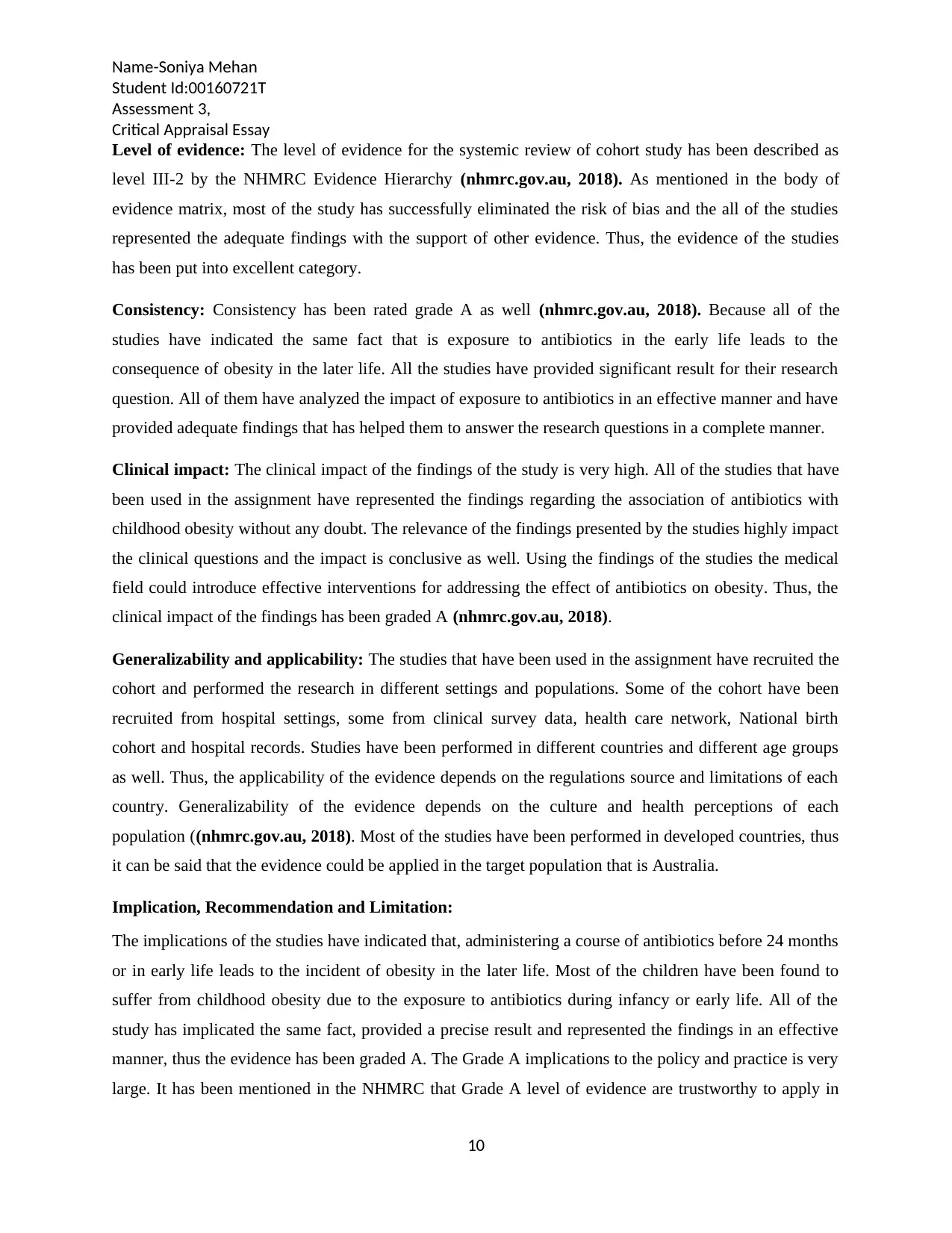
Name-Soniya Mehan
Student Id:00160721T
Assessment 3,
Critical Appraisal Essay
Level of evidence: The level of evidence for the systemic review of cohort study has been described as
level III-2 by the NHMRC Evidence Hierarchy (nhmrc.gov.au, 2018). As mentioned in the body of
evidence matrix, most of the study has successfully eliminated the risk of bias and the all of the studies
represented the adequate findings with the support of other evidence. Thus, the evidence of the studies
has been put into excellent category.
Consistency: Consistency has been rated grade A as well (nhmrc.gov.au, 2018). Because all of the
studies have indicated the same fact that is exposure to antibiotics in the early life leads to the
consequence of obesity in the later life. All the studies have provided significant result for their research
question. All of them have analyzed the impact of exposure to antibiotics in an effective manner and have
provided adequate findings that has helped them to answer the research questions in a complete manner.
Clinical impact: The clinical impact of the findings of the study is very high. All of the studies that have
been used in the assignment have represented the findings regarding the association of antibiotics with
childhood obesity without any doubt. The relevance of the findings presented by the studies highly impact
the clinical questions and the impact is conclusive as well. Using the findings of the studies the medical
field could introduce effective interventions for addressing the effect of antibiotics on obesity. Thus, the
clinical impact of the findings has been graded A (nhmrc.gov.au, 2018).
Generalizability and applicability: The studies that have been used in the assignment have recruited the
cohort and performed the research in different settings and populations. Some of the cohort have been
recruited from hospital settings, some from clinical survey data, health care network, National birth
cohort and hospital records. Studies have been performed in different countries and different age groups
as well. Thus, the applicability of the evidence depends on the regulations source and limitations of each
country. Generalizability of the evidence depends on the culture and health perceptions of each
population ((nhmrc.gov.au, 2018). Most of the studies have been performed in developed countries, thus
it can be said that the evidence could be applied in the target population that is Australia.
Implication, Recommendation and Limitation:
The implications of the studies have indicated that, administering a course of antibiotics before 24 months
or in early life leads to the incident of obesity in the later life. Most of the children have been found to
suffer from childhood obesity due to the exposure to antibiotics during infancy or early life. All of the
study has implicated the same fact, provided a precise result and represented the findings in an effective
manner, thus the evidence has been graded A. The Grade A implications to the policy and practice is very
large. It has been mentioned in the NHMRC that Grade A level of evidence are trustworthy to apply in
10
Student Id:00160721T
Assessment 3,
Critical Appraisal Essay
Level of evidence: The level of evidence for the systemic review of cohort study has been described as
level III-2 by the NHMRC Evidence Hierarchy (nhmrc.gov.au, 2018). As mentioned in the body of
evidence matrix, most of the study has successfully eliminated the risk of bias and the all of the studies
represented the adequate findings with the support of other evidence. Thus, the evidence of the studies
has been put into excellent category.
Consistency: Consistency has been rated grade A as well (nhmrc.gov.au, 2018). Because all of the
studies have indicated the same fact that is exposure to antibiotics in the early life leads to the
consequence of obesity in the later life. All the studies have provided significant result for their research
question. All of them have analyzed the impact of exposure to antibiotics in an effective manner and have
provided adequate findings that has helped them to answer the research questions in a complete manner.
Clinical impact: The clinical impact of the findings of the study is very high. All of the studies that have
been used in the assignment have represented the findings regarding the association of antibiotics with
childhood obesity without any doubt. The relevance of the findings presented by the studies highly impact
the clinical questions and the impact is conclusive as well. Using the findings of the studies the medical
field could introduce effective interventions for addressing the effect of antibiotics on obesity. Thus, the
clinical impact of the findings has been graded A (nhmrc.gov.au, 2018).
Generalizability and applicability: The studies that have been used in the assignment have recruited the
cohort and performed the research in different settings and populations. Some of the cohort have been
recruited from hospital settings, some from clinical survey data, health care network, National birth
cohort and hospital records. Studies have been performed in different countries and different age groups
as well. Thus, the applicability of the evidence depends on the regulations source and limitations of each
country. Generalizability of the evidence depends on the culture and health perceptions of each
population ((nhmrc.gov.au, 2018). Most of the studies have been performed in developed countries, thus
it can be said that the evidence could be applied in the target population that is Australia.
Implication, Recommendation and Limitation:
The implications of the studies have indicated that, administering a course of antibiotics before 24 months
or in early life leads to the incident of obesity in the later life. Most of the children have been found to
suffer from childhood obesity due to the exposure to antibiotics during infancy or early life. All of the
study has implicated the same fact, provided a precise result and represented the findings in an effective
manner, thus the evidence has been graded A. The Grade A implications to the policy and practice is very
large. It has been mentioned in the NHMRC that Grade A level of evidence are trustworthy to apply in
10
Paraphrase This Document
Need a fresh take? Get an instant paraphrase of this document with our AI Paraphraser
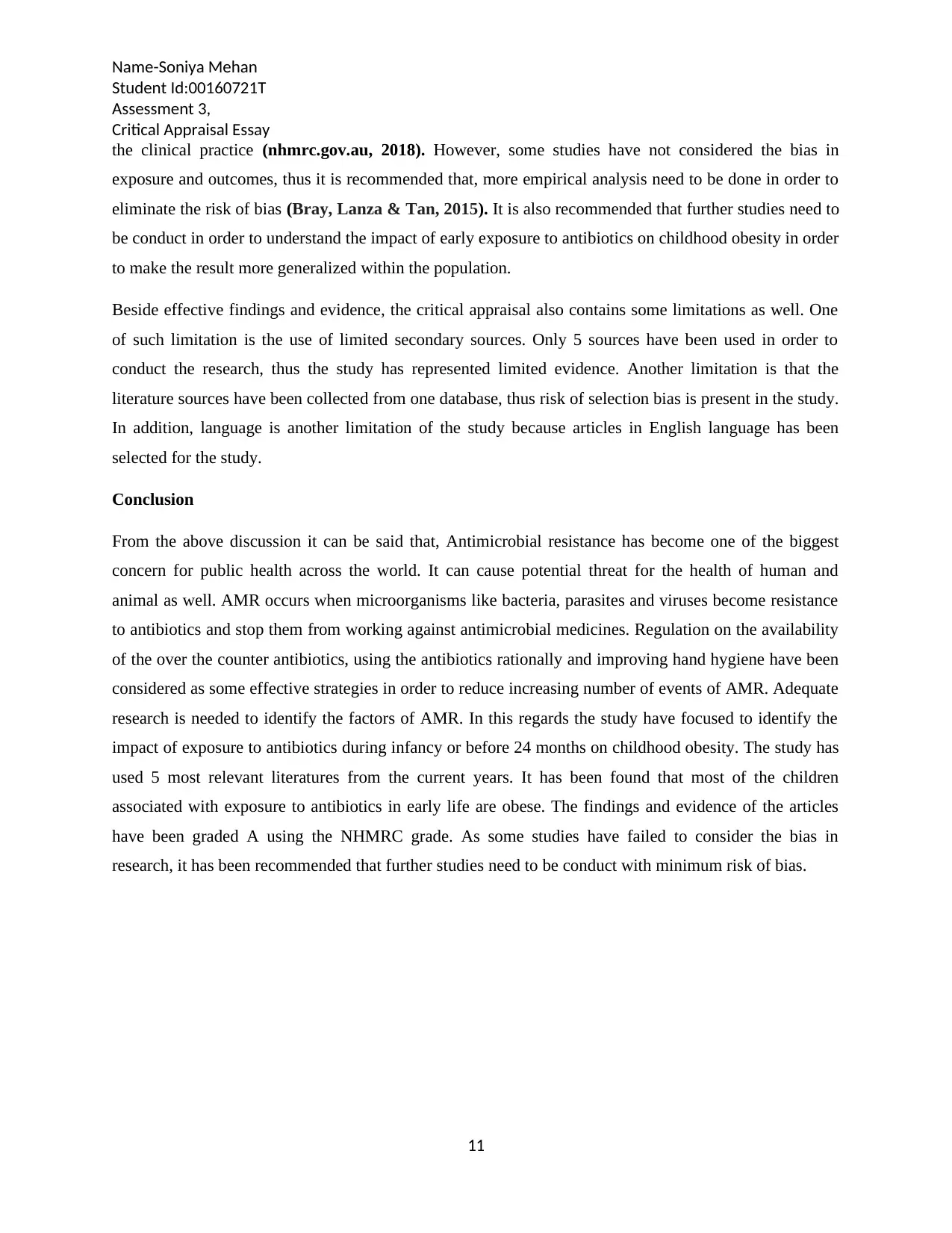
Name-Soniya Mehan
Student Id:00160721T
Assessment 3,
Critical Appraisal Essay
the clinical practice (nhmrc.gov.au, 2018). However, some studies have not considered the bias in
exposure and outcomes, thus it is recommended that, more empirical analysis need to be done in order to
eliminate the risk of bias (Bray, Lanza & Tan, 2015). It is also recommended that further studies need to
be conduct in order to understand the impact of early exposure to antibiotics on childhood obesity in order
to make the result more generalized within the population.
Beside effective findings and evidence, the critical appraisal also contains some limitations as well. One
of such limitation is the use of limited secondary sources. Only 5 sources have been used in order to
conduct the research, thus the study has represented limited evidence. Another limitation is that the
literature sources have been collected from one database, thus risk of selection bias is present in the study.
In addition, language is another limitation of the study because articles in English language has been
selected for the study.
Conclusion
From the above discussion it can be said that, Antimicrobial resistance has become one of the biggest
concern for public health across the world. It can cause potential threat for the health of human and
animal as well. AMR occurs when microorganisms like bacteria, parasites and viruses become resistance
to antibiotics and stop them from working against antimicrobial medicines. Regulation on the availability
of the over the counter antibiotics, using the antibiotics rationally and improving hand hygiene have been
considered as some effective strategies in order to reduce increasing number of events of AMR. Adequate
research is needed to identify the factors of AMR. In this regards the study have focused to identify the
impact of exposure to antibiotics during infancy or before 24 months on childhood obesity. The study has
used 5 most relevant literatures from the current years. It has been found that most of the children
associated with exposure to antibiotics in early life are obese. The findings and evidence of the articles
have been graded A using the NHMRC grade. As some studies have failed to consider the bias in
research, it has been recommended that further studies need to be conduct with minimum risk of bias.
11
Student Id:00160721T
Assessment 3,
Critical Appraisal Essay
the clinical practice (nhmrc.gov.au, 2018). However, some studies have not considered the bias in
exposure and outcomes, thus it is recommended that, more empirical analysis need to be done in order to
eliminate the risk of bias (Bray, Lanza & Tan, 2015). It is also recommended that further studies need to
be conduct in order to understand the impact of early exposure to antibiotics on childhood obesity in order
to make the result more generalized within the population.
Beside effective findings and evidence, the critical appraisal also contains some limitations as well. One
of such limitation is the use of limited secondary sources. Only 5 sources have been used in order to
conduct the research, thus the study has represented limited evidence. Another limitation is that the
literature sources have been collected from one database, thus risk of selection bias is present in the study.
In addition, language is another limitation of the study because articles in English language has been
selected for the study.
Conclusion
From the above discussion it can be said that, Antimicrobial resistance has become one of the biggest
concern for public health across the world. It can cause potential threat for the health of human and
animal as well. AMR occurs when microorganisms like bacteria, parasites and viruses become resistance
to antibiotics and stop them from working against antimicrobial medicines. Regulation on the availability
of the over the counter antibiotics, using the antibiotics rationally and improving hand hygiene have been
considered as some effective strategies in order to reduce increasing number of events of AMR. Adequate
research is needed to identify the factors of AMR. In this regards the study have focused to identify the
impact of exposure to antibiotics during infancy or before 24 months on childhood obesity. The study has
used 5 most relevant literatures from the current years. It has been found that most of the children
associated with exposure to antibiotics in early life are obese. The findings and evidence of the articles
have been graded A using the NHMRC grade. As some studies have failed to consider the bias in
research, it has been recommended that further studies need to be conduct with minimum risk of bias.
11
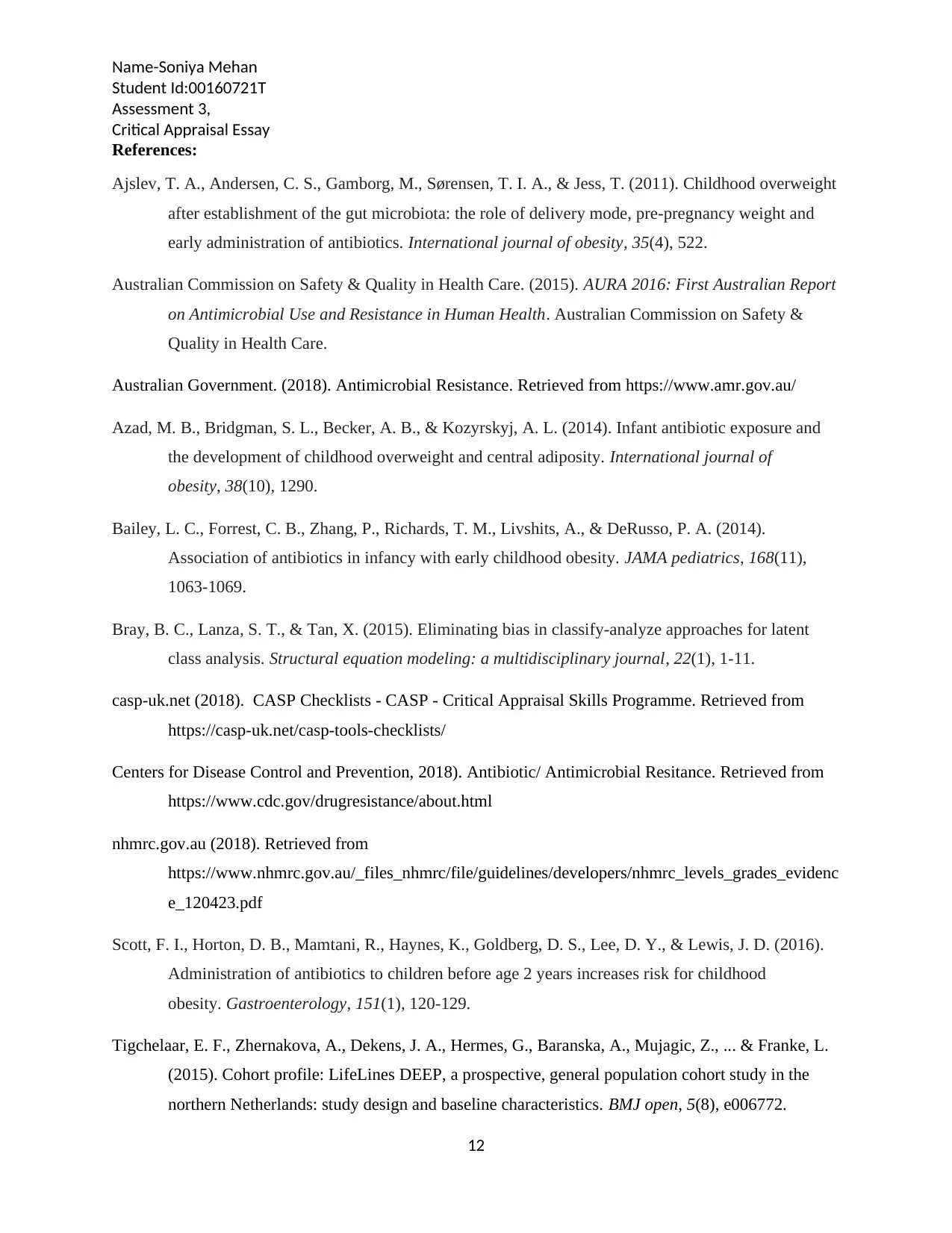
Name-Soniya Mehan
Student Id:00160721T
Assessment 3,
Critical Appraisal Essay
References:
Ajslev, T. A., Andersen, C. S., Gamborg, M., Sørensen, T. I. A., & Jess, T. (2011). Childhood overweight
after establishment of the gut microbiota: the role of delivery mode, pre-pregnancy weight and
early administration of antibiotics. International journal of obesity, 35(4), 522.
Australian Commission on Safety & Quality in Health Care. (2015). AURA 2016: First Australian Report
on Antimicrobial Use and Resistance in Human Health. Australian Commission on Safety &
Quality in Health Care.
Australian Government. (2018). Antimicrobial Resistance. Retrieved from https://www.amr.gov.au/
Azad, M. B., Bridgman, S. L., Becker, A. B., & Kozyrskyj, A. L. (2014). Infant antibiotic exposure and
the development of childhood overweight and central adiposity. International journal of
obesity, 38(10), 1290.
Bailey, L. C., Forrest, C. B., Zhang, P., Richards, T. M., Livshits, A., & DeRusso, P. A. (2014).
Association of antibiotics in infancy with early childhood obesity. JAMA pediatrics, 168(11),
1063-1069.
Bray, B. C., Lanza, S. T., & Tan, X. (2015). Eliminating bias in classify-analyze approaches for latent
class analysis. Structural equation modeling: a multidisciplinary journal, 22(1), 1-11.
casp-uk.net (2018). CASP Checklists - CASP - Critical Appraisal Skills Programme. Retrieved from
https://casp-uk.net/casp-tools-checklists/
Centers for Disease Control and Prevention, 2018). Antibiotic/ Antimicrobial Resitance. Retrieved from
https://www.cdc.gov/drugresistance/about.html
nhmrc.gov.au (2018). Retrieved from
https://www.nhmrc.gov.au/_files_nhmrc/file/guidelines/developers/nhmrc_levels_grades_evidenc
e_120423.pdf
Scott, F. I., Horton, D. B., Mamtani, R., Haynes, K., Goldberg, D. S., Lee, D. Y., & Lewis, J. D. (2016).
Administration of antibiotics to children before age 2 years increases risk for childhood
obesity. Gastroenterology, 151(1), 120-129.
Tigchelaar, E. F., Zhernakova, A., Dekens, J. A., Hermes, G., Baranska, A., Mujagic, Z., ... & Franke, L.
(2015). Cohort profile: LifeLines DEEP, a prospective, general population cohort study in the
northern Netherlands: study design and baseline characteristics. BMJ open, 5(8), e006772.
12
Student Id:00160721T
Assessment 3,
Critical Appraisal Essay
References:
Ajslev, T. A., Andersen, C. S., Gamborg, M., Sørensen, T. I. A., & Jess, T. (2011). Childhood overweight
after establishment of the gut microbiota: the role of delivery mode, pre-pregnancy weight and
early administration of antibiotics. International journal of obesity, 35(4), 522.
Australian Commission on Safety & Quality in Health Care. (2015). AURA 2016: First Australian Report
on Antimicrobial Use and Resistance in Human Health. Australian Commission on Safety &
Quality in Health Care.
Australian Government. (2018). Antimicrobial Resistance. Retrieved from https://www.amr.gov.au/
Azad, M. B., Bridgman, S. L., Becker, A. B., & Kozyrskyj, A. L. (2014). Infant antibiotic exposure and
the development of childhood overweight and central adiposity. International journal of
obesity, 38(10), 1290.
Bailey, L. C., Forrest, C. B., Zhang, P., Richards, T. M., Livshits, A., & DeRusso, P. A. (2014).
Association of antibiotics in infancy with early childhood obesity. JAMA pediatrics, 168(11),
1063-1069.
Bray, B. C., Lanza, S. T., & Tan, X. (2015). Eliminating bias in classify-analyze approaches for latent
class analysis. Structural equation modeling: a multidisciplinary journal, 22(1), 1-11.
casp-uk.net (2018). CASP Checklists - CASP - Critical Appraisal Skills Programme. Retrieved from
https://casp-uk.net/casp-tools-checklists/
Centers for Disease Control and Prevention, 2018). Antibiotic/ Antimicrobial Resitance. Retrieved from
https://www.cdc.gov/drugresistance/about.html
nhmrc.gov.au (2018). Retrieved from
https://www.nhmrc.gov.au/_files_nhmrc/file/guidelines/developers/nhmrc_levels_grades_evidenc
e_120423.pdf
Scott, F. I., Horton, D. B., Mamtani, R., Haynes, K., Goldberg, D. S., Lee, D. Y., & Lewis, J. D. (2016).
Administration of antibiotics to children before age 2 years increases risk for childhood
obesity. Gastroenterology, 151(1), 120-129.
Tigchelaar, E. F., Zhernakova, A., Dekens, J. A., Hermes, G., Baranska, A., Mujagic, Z., ... & Franke, L.
(2015). Cohort profile: LifeLines DEEP, a prospective, general population cohort study in the
northern Netherlands: study design and baseline characteristics. BMJ open, 5(8), e006772.
12
⊘ This is a preview!⊘
Do you want full access?
Subscribe today to unlock all pages.

Trusted by 1+ million students worldwide
1 out of 13
Related Documents
Your All-in-One AI-Powered Toolkit for Academic Success.
+13062052269
info@desklib.com
Available 24*7 on WhatsApp / Email
![[object Object]](/_next/static/media/star-bottom.7253800d.svg)
Unlock your academic potential
Copyright © 2020–2025 A2Z Services. All Rights Reserved. Developed and managed by ZUCOL.





